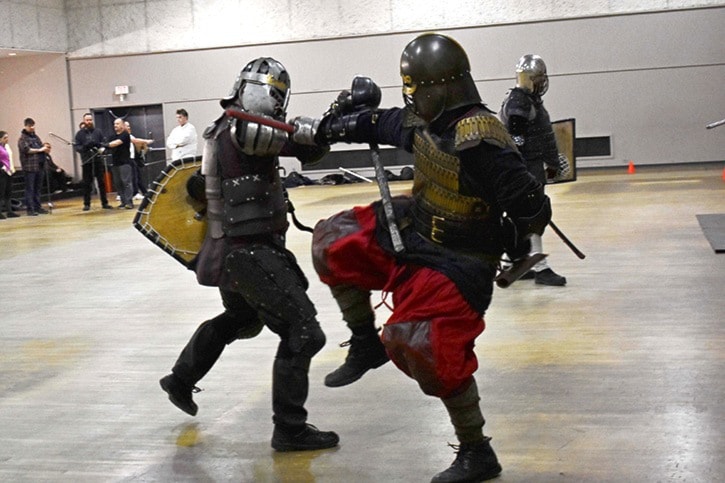Outside, in the parking lot of Cloverdale’s Shannon Hall, medieval warriors pulled swords and armour from the back of an SUV. Two men stood beneath an electric porch light, practicing swordplay with rapiers.
They were waiting for the fight to start.
Once inside, they pulled metal gauntlets over long sleeve shirts and tied greaves to their shins. Some donned sports helms—metal helmets with a gated mask to protect against glancing blows. Others picked up painted shields, and all had hefty, padded weapons in hand.
This wasn’t just fanciful imaginings; All of the fighters are part of the Society for Creative Anachronism (SCA), a group devoted to medieval study and reenactment, and each of them has a different persona they play when they are with the group.
“You get to reinvent yourself really,” Baroness Caitrina inghean Aindriasa, more commonly known as Roxanne Hood, said.
Her husband, Baron Uilliam mac Fearchair mhic Gillie Aindrias (Mark Hood), agreed.
“You get to be the person you thought you should have been,” he said.
The SCA is divided into kingdoms, large geographic groups that span international boundaries. Inside each kingdom are different principalities, and within the principalities there are baronies.
Much of Greater Vancouver falls inside the Barony of Lions Gate, including Delta, Surrey, Richmond, Burnaby, Coquitlam, Langley, Lions Bay, New Westminster, North Vancouver, Port Coquitlam, Port Moody, Squamish, Vancouver and White Rock, as well as some places a bit farther afield like Bowen Island, Britannia Beach and Whistler.
The Barony of Lions Gate has been around for 40 years, and for nearly all of that time it has been at war with the Barony of Seagirt, located in Victoria.The Hoods recently journeyed to Seagirt to declare war, this time over lost paperwork.
“That’s the reason we have this practice,” Mark Hood said, watching the fighters spar, “so we can go actually get our armies together and have a good war.”
STORY CONTINUES BELOW PHOTO

People from as far away as Squamish and Bellingham came out to the practice in Cloverdale. Grace Kennedy
Heavy combat isn’t the only thing people do in the SCA—and it’s not the only thing that can win a war.
Wars in the SCA are won on a point system. When the Barony of Lions Gate “invades” the Barony of Seagirt, they’ll compete to win points in bardic skills (i.e. song and storytelling), “arts and sciences” (which includes everything from calligraphy to board games), fencing, archery, children’s archery and, of course, combat.
“It’s a huge creative outlet, nine ways from Sunday, no matter how you look at it,” Mistress Agnes (Vanessa Giddings) said. “It’s a creative outlet for all of us, whether we’re creating a different world to live in, or whether we’re creating outfits from scratch, or whether we’re feeding the dream.”
Many people who join the SCA stay in it for years. Giddings has been in the SCA for 22 years. Mark Hood started when he was 16 and got serious about the group in 1986. But Duke Paul Bellatrix holds the real title for longevity.
Duke Paul (or Paul Porter, as he’s known outside the SCA) isn’t from the Barony of Lions Gate, but rather a smaller group called the Shire of Thornwold based out of Ferndale, Bellingham. He brought two of his students to participate in the Barony’s combat practice, and when the Baron and Baroness saw him standing across the hall, they were shocked.
“Oh my god.” Mark Hood said. “Paul’s here.”
“Duke Paul?”
“Duke Paul.”
Porter is something of a legend. He’s been in the SCA since 1970, only five years after it started. He’s been king eight times – meaning he’s won a crown tournament against other fighters in the kingdom – and he said he could have won every other tournament from the early ‘70s until 1985, “but that’s a little silly and it’s a little selfish.”
And according to the Baroness, Porter invented fighting in the SCA.
In 1970, the SCA was a comparatively small group. Combat was unfocused and slow, and the fighters didn’t hit very hard. When Porter joined, he applied the principles he learned while earning his black belt in judo and fighting on his varsity team to his fighting style, and suddenly, everything about combat in the SCA changed.
“There’s no way somebody who isn’t doing that could keep up with you,” Porter said.
Unlike other types of fighting reenactments, people in the SCA are actually hitting each other. Hard.
There are rules fighters have to follow to avoid hurting their opponents but, “what we do, we do full-speed, full-force,” Porter said. “So we get really, really good at it.
“If we wanted to go fight for real, we’d just have to put in some grappling, and…after a while it would get really nasty.”
The full-speed, full-force principle was fully present in the final match-up of the Cloverdale tournament. A knight – identified by the white scrap of fabric around his waist – was fighting a blue-clad warrior inside a circle of onlookers.
The sound of padded wood on metal reverberated throughout the hall. Their blunted swords slashed through the air, hitting helmets, shields, shins.
A flurry of movement and the blue warrior was on his knees. Moments later he collapsed on the ground, signalling defeat.
From across the room, a fighter in a white T-shirt ran at the victorious knight. Without giving him time to remove his helmet, the man leaped on the knight and hugged him.
“The thing is with [judo], you got through practice, you walked out, sometimes you went and had a pizza but that was it,” Porter said.
“But now with [the SCA], you walk out of practice and you’ve got a whole social group that’s world-wide that you can play in and have relationships with.
“It’s one of the coolest things going actually.”
